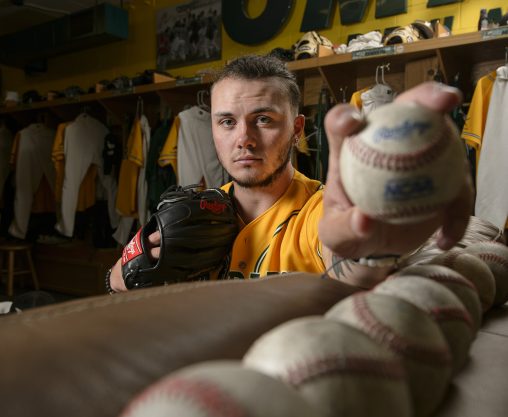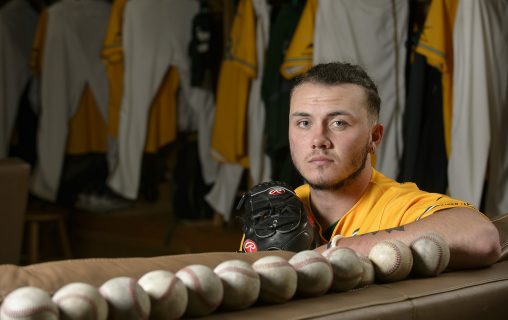
Starting pitcher Daniel Sexton was named to the Horizon League’s Second Team and helped lead the baseball team to the finals of the league tournament. (Photos by Will Jones)
Baseball was his favorite sport “right out of the gate.” Daniel Sexton remembers his father dressed for work in coat and tie and playing catch with him and his big brother while the boys waited for the school bus in the mornings.
Today, Sexton is one of Wright State University’s star pitchers. This season, he sported an 8-2 record, led the Horizon League in batters struck out looking, ranked fifth in earned run average and tried not to get distracted by talk that he’ll be drafted by the pros like his brother.
The 21-year-old Sexton is just one of 300 student-athletes at Wright State who helped the university finish second in the Horizon League in 2016-17 in an athletics program that spends the second least amount of any school in the league and the least amount of the 11 Division I schools in Ohio.
“I would make the argument that overall program-wise in our 29 years of Division I, we are as successful as we’ve ever been, all while doing it in a very economical way,” said Bob Grant, who became the school’s athletics director in 2008.
The baseball team was ranked in the Top 25 this year for the first time ever and went to the NCAA Regional Finals the previous two years in a row. Men’s basketball won 20 games under new head coach Scott Nagy. Women’s basketball was co-champions of the Horizon League regular season, received votes in the Top 25 and played in the Women’s NIT for the third straight year. Men’s soccer won the Horizon League regular season and advanced to the tournament championship game for the third straight year. And Wright State’s Ryan Wenzler was the co-champion of the Horizon League Golf Championship.
Wright State spends about $12 million a year on athletics, or about 3 percent of the university’s budget. That compares to an average of 6 percent nationally by non-football universities like Wright State.
“I am really proud of the fact that we in a very purposeful way have kept our spending down,” said Grant.
The lion’s share of the athletics department’s budget is spent on scholarships, salaries, travel and equipment. Of Wright State’s 300 student-athletes, those on the volleyball team and men’s and women’s basketball teams are all on full scholarships. The others are either on partial scholarships or get no financial assistance from athletics at all.
Student-athletes pay $1.3 million in tuition dollars to the university. Combined with $500,000 in state support for graduating student-athletes from Ohio, the total jumps to $1.8 million.
“This is not a win-at-all-costs place flush with cash. That is not us,” said Grant. “We’re competing with a smaller budget, but mainly through private donations we have been able to build some terrific facilities. And we are constantly working to improve our facilities.”
Most of the facility upgrades have been done with private dollars.
The Setzer Pavilion/Mills Morgan Center — the basketball training facility — is the only entirely privately funded facility in the history of Wright State. Before it was built, the basketball teams shared the Nutter Center with a professional hockey team and the adjoining McLin Gym with intramural teams, ROTC and other groups.
“We needed to make sure our basketball teams had a place to practice and get better 24-7,” said Grant. “The pavilion is the envy of many, many people around the country.”
The lion’s share of funding for baseball’s Nischwitz Stadium came from private dollars, including the recent addition of new turf and a pressbox. Funding has been lined up for new tennis courts, and there is some seed money for an indoor baseball/softball/golf hitting facility.
“We have had to rely on creativity, help from the community. It’s not been easy,” said Grant. “But when you sit and talk with donors, community leaders, and movers and shakers, and they get around our student-athletes and see how high-achieving they are, that they have their priorities straight, it’s probably a much easier sell than it could be.”
The department’s modest budget can adversely affect recruiting.
“When you are an 18- or 17-year-old trying to decide where you’re going to spend your next four years, you are oftentimes wowed by glitz and by facilities and by the way somebody travels,” Grant said. “So we’ll lose some recruiting battles. But our coaches have been really smart about getting the right kind of kids that fit our culture.”

A junior majoring in organizational leadership, Daniel Sexton’s long-term career goal after any professional baseball he might play is to go into computer science.
Sexton said the baseball team plays with a chip on its shoulder because many of the players were passed over by bigger universities.
“They come here and they just want to smack teams in the mouth,” Sexton said. “They’re a bunch of guys who want to prove they are good enough to play at those schools.”
For example, in February the Raiders went to South Carolina and beat No. 10 Clemson two out of three games.
“We’re just a bunch of bulldogs who want to win,” said Sexton. “It’s called that Raider magic; it’s that Raider gang mentality. Everything is for the team.”
Sexton grew up in Columbus, Ohio. He began playing organized sports at age 4 and started pitching when he was 7. After graduating from high school, he attended the University of Tiffin, transferred to Sinclair College and then to Wright State, in 2015. His older brother, Robby, pitched for Wright State last year and was drafted by the Boston Red Sox organization.
The left-handed Sexton can’t throw quite as fast as his brother, so he concentrated on his accuracy and pitch selection.
“Hitting a good spot will get a guy out nine times out of 10 over throwing hard right down the middle,” he said.
However, his strongest pitch is a fastball, which has a lot of lateral movement — moving up to half a foot as it crosses the plate.
“I get a lot of inside-looking strikeouts,” he said.
Sexton was named to the Horizon League’s Second Team. He led the league in batters struck out looking (27) and tied for second in wins (8). He ranked fifth in earned run average (2.80) and innings pitched (83.2) and sixth in opposing batting average (.237).
The Horizon League Pitcher of the Week on Feb. 20 and March 27, Sexton picked up wins over Clemson, South Carolina and Pittsburgh along with Valparaiso, Milwaukee, Oakland, Northern Kentucky and the University of Illinois-Chicago during league play. He struck out a season-high nine against Oakland on April 22 and had seven strikeouts at Clemson on Feb. 19.
A junior majoring in organizational leadership, Sexton’s long-term career goal after any professional baseball he might play is to go into computer science.
Playing professional baseball “is definitely on my mind,” he says. “But I try to block it out as much as possible because I just want to win.”

 Milling around
Milling around  Wright State recognizes Nursing Professor Kim Ringo for advancing international student success
Wright State recognizes Nursing Professor Kim Ringo for advancing international student success  Wright State honors graduating students for distinguished doctoral dissertations
Wright State honors graduating students for distinguished doctoral dissertations  Top 10 Newsroom videos of 2025
Top 10 Newsroom videos of 2025  Museum-quality replica of historic Hawthorn Hill donated to Wright State
Museum-quality replica of historic Hawthorn Hill donated to Wright State 